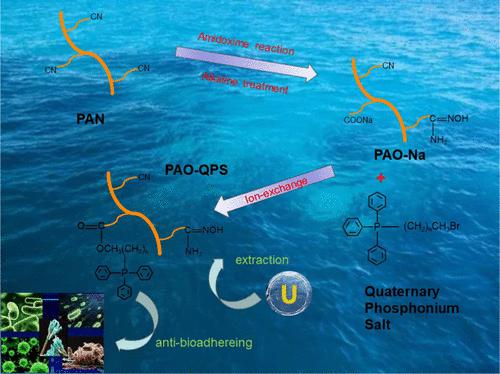当前位置:
X-MOL 学术
›
ACS Appl. Polym. Mater.
›
论文详情
Our official English website, www.x-mol.net, welcomes your feedback! (Note: you will need to create a separate account there.)
Preparation of Antibioadhering Materials Containing Quaternary Phosphonium Salt for Uranium Extraction from Seawater
ACS Applied Polymer Materials ( IF 5 ) Pub Date : 2024-03-19 , DOI: 10.1021/acsapm.3c03101 He Li 1 , Shusen Chen 1 , Yan Song 1 , Haiyun Ding 1 , Ziming Li 1 , Haotian Wu 1 , Fengju Wang 1 , Hao Li 1 , Ziteng Gao 1 , Haizhen Wang 1
ACS Applied Polymer Materials ( IF 5 ) Pub Date : 2024-03-19 , DOI: 10.1021/acsapm.3c03101 He Li 1 , Shusen Chen 1 , Yan Song 1 , Haiyun Ding 1 , Ziming Li 1 , Haotian Wu 1 , Fengju Wang 1 , Hao Li 1 , Ziteng Gao 1 , Haizhen Wang 1
Affiliation

|
In this paper, three antibioadhering materials with quaternary phosphonium salt-modified polyamidoxime (PAO-QPS) for uranium extraction from seawater were prepared using commercial polyacrylonitrile fiber as the base material by the ion-exchange method. Infrared spectroscopy and thermogravimetric analysis were used to verify the correctness of the structure and to test the thermal stability of the synthetic materials. Scanning electron microscopy was used to analyze the microscopic appearance of the material surface. X-ray photoelectron spectroscopy was used to determine the composition of the surface elements before and after modification of the material and after adsorption of uranium. The uranium adsorption and biological adhesion resistance of the materials were tested. Polyamidoxime-modified hexyltriphenylphosphonium bromide (PAO-C6) was the best adsorption material among the three quaternary phosphonium salt-modified materials with different alkyl chains. The adsorption kinetic curve and adsorption isotherm were drawn according to the uranium adsorption results. The results showed that the adsorption time and temperature were positively correlated to the uranium adsorption capacity of PAO-C6. The maximum uranium adsorption capacity of PAO-C6 could reach 23.6 mg·g–1 in the simulated seawater with a uranium concentration of 3.3 mg·L–1. In addition, the inhibition rates of the material to Escherichia coli and Staphylococcus aureus were 87.60 and 90.59%, respectively, and the inhibition rate against marine bacteria reached 80.61%, indicating that PAO-C6 has good antibioadhering properties. PAO-C6 was expected to be used for uranium extraction from seawater.
中文翻译:

海水提铀用含季磷盐抗生物粘附材料的制备
以商用聚丙烯腈纤维为基材,采用离子交换法制备了三种用于海水提铀的季鏻盐改性聚酰胺肟(PAO-QPS)抗生物粘附材料。利用红外光谱和热重分析验证了结构的正确性并测试了合成材料的热稳定性。使用扫描电子显微镜来分析材料表面的微观形貌。采用X射线光电子能谱测定材料改性前后以及吸附铀后的表面元素组成。测试了材料的铀吸附性和生物粘附性。聚酰胺肟改性己基三苯基溴化鏻(PAO-C6)是三种不同烷基链季鏻盐改性材料中吸附效果最好的材料。根据铀吸附结果绘制了吸附动力学曲线和吸附等温线。结果表明,吸附时间和温度与PAO-C6的铀吸附能力呈正相关。在铀浓度为3.3 mg·L –1的模拟海水中,PAO-C6的最大铀吸附量可达23.6 mg·g –1。此外,该材料对大肠杆菌和金黄色葡萄球菌的抑制率分别为87.60和90.59%,对海洋细菌的抑制率达到80.61%,表明PAO-C6具有良好的抗生物粘附性能。 PAO-C6预计将用于从海水中提取铀。
更新日期:2024-03-19
中文翻译:

海水提铀用含季磷盐抗生物粘附材料的制备
以商用聚丙烯腈纤维为基材,采用离子交换法制备了三种用于海水提铀的季鏻盐改性聚酰胺肟(PAO-QPS)抗生物粘附材料。利用红外光谱和热重分析验证了结构的正确性并测试了合成材料的热稳定性。使用扫描电子显微镜来分析材料表面的微观形貌。采用X射线光电子能谱测定材料改性前后以及吸附铀后的表面元素组成。测试了材料的铀吸附性和生物粘附性。聚酰胺肟改性己基三苯基溴化鏻(PAO-C6)是三种不同烷基链季鏻盐改性材料中吸附效果最好的材料。根据铀吸附结果绘制了吸附动力学曲线和吸附等温线。结果表明,吸附时间和温度与PAO-C6的铀吸附能力呈正相关。在铀浓度为3.3 mg·L –1的模拟海水中,PAO-C6的最大铀吸附量可达23.6 mg·g –1。此外,该材料对大肠杆菌和金黄色葡萄球菌的抑制率分别为87.60和90.59%,对海洋细菌的抑制率达到80.61%,表明PAO-C6具有良好的抗生物粘附性能。 PAO-C6预计将用于从海水中提取铀。



























 京公网安备 11010802027423号
京公网安备 11010802027423号